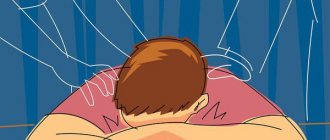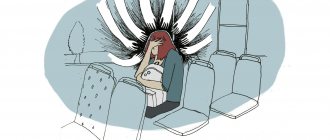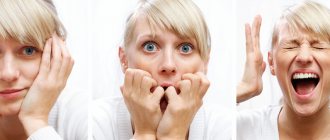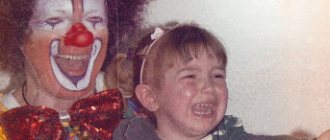Anxiety disorder is a group of neuroses that includes generalized anxiety disorder, panic disorder and social anxiety disorder, as well as a number of specific phobias. Anxiety disorder is one of the most common mental illnesses. According to various estimates, every fifth person has experienced anxiety and/or depression to some degree.
Mixed anxiety and depressive disorder
- Mixed anxiety-depressive disorder is a rather controversial phenomenon, and not all existing diagnostic classifications include it. It is not that its existence is not recognized, and it is sometimes considered a depressive disorder with secondary anxiety characteristics rather than a single disorder.
- Mixed symptoms of anxiety-depressive disorder include anxiety and depression, but neither is clearly predominant. Neither is each of sufficient intensity to justify a separate diagnosis.
- The disorder presents with a mixture of relatively mild symptoms that are seen quite frequently in primary care, and its prevalence is high in the general population.
- The combination of depressive and anxiety symptoms causes significant impairment in the affected person's functioning.
IMPORTANT! However, those who oppose this diagnosis argue that the presence of this diagnosis prevents clinicians from distinguishing true depressive disorders from true anxiety disorders and takes away the time needed to obtain a complete psychiatric history of the patient.
We recommend reading the article
"Free psychological help in Russia"
Find out about
how depression progresses
Mechanism of occurrence and course of the disease
Anxiety neurosis can be fueled by some objective reasons: information about layoffs, an aggressive leadership style, difficult relationships with colleagues or relatives, emotional articles in the media or television programs. Normally, all these events occupy a person’s thoughts for a short time.
But sometimes strong emotional stress, deep-seated emotional drives (obsessive, aggressive, sexual) cause constant painful multi-day thoughts on the topics: if there is a dismissal in our country, will I be fired, how to behave if the boss is rude to me, what to do if in the country a war, famine, a coup will begin... These thoughts, which have no specific reason, completely occupy attention, are considered from all sides, a person constantly makes supposed plans and fictitious dialogues. This is how the neurosis of fear and anxiety arises and develops under the influence of psychological factors.
The cause of the disease can also be physiological factors - hormonal changes (including age-related, in pregnant women, etc.), pathologies in the endocrine system (adrenal glands, which affect hormonal levels, thyroid gland), excessive intellectual or physical stress, diseases of a general nature. Anxiety neurosis occurs in acute form, but more often it is chronic. It can arise as a consequence of an attack of sudden intense fear or develop gradually. Regardless of the mechanism of occurrence and severity, the disease worries for a long time, accompanied by a distinct feeling of internal tension and discomfort, as well as symptoms of a physiological nature.
When is mixed anxiety-depressive disorder diagnosed?
To diagnose it, it is necessary to record the presence of low-intensity symptoms of anxiety and depression. In addition, there should be some autonomic symptoms such as tremors, palpitations, dry mouth and abdominal pain.
Please note: Some preliminary research has shown that mixed anxiety-depressive disorder is rarely diagnosed by general practitioners. However, it is possible that this lack of recognition only reflects the lack of an appropriate diagnostic label for these patients.
Maintenance pharmacological therapy
A meta-analysis showed that long-term use of SSRIs (6–12 months) was effective in preventing relapse (odds ratio for relapse = 0.20).
Relapse after 6-18 months of duloxetine, escitalopram, paroxetine and venlayaxin XR was observed in 10-20% of cases, compared with 40-56% in the control group. Continuing pregabalin and quetiapine XR also prevents relapse after 6-12 months.
Long-term RCTs have shown that escitalopram, paroxetine and venlafaxine XR help maintain benefit over six months.
Anxiety-depressive disorder symptoms
- The clinical manifestations of this disorder combine symptoms of anxiety disorders and symptoms of depressive disorders.
- In addition, symptoms of autonomic nervous system overactivity, such as gastrointestinal discomfort, are common. This is why patients often seek medical help first.
DSM - criteria for mixed anxiety-depressive disorder
- The Diagnostic and Statistical Manual of Mental Disorders (DSM) puts forward a number of criteria for diagnosing this disorder. However, as we already mentioned, this is for research purposes only.
- An essential characteristic of this disorder is persistent or recurrent dysphoria (decreased mood) that lasts for at least 1 month. This condition is accompanied by additional symptoms of the same duration, including at least four of the following:
- Difficulty concentrating or memory, sleep disturbances, fatigue or lack of energy.
- Acute irritability.
- Permanent and intense anxiety.
- Increased tearfulness or feelings of hopelessness, pessimism about the future, worthlessness and low self-esteem.
- Increased vigilance, anticipation of danger.
These symptoms cause significant clinical discomfort or impairment in social, work, or other important activities.
- On the other hand, mixed anxiety-depressive disorder should not be diagnosed when symptoms are due to direct physiological effects of certain substances or other medical conditions. Or if the person has at any time been diagnosed with major depressive disorder, persistent depressive disorder, anxiety disorder, or generalized anxiety disorder.
- This diagnosis is also inappropriate if criteria for any other anxiety or mood disorder are simultaneously met, even if they are in partial remission.
- It is also necessary that the spectrum of symptoms cannot be consistent with another mental disorder. Much of the primary information about this disorder comes from primary care centers, where the disorder is more common and likely also has a higher prevalence among outpatients.
The main symptoms of anxious depression are:
- a feeling of anxiety that has no specific cause and almost does not leave the patient during the day;
- increased anxiety, tearfulness, irritability, inadequate alarm reaction to any unplanned events,
- low mood, feeling of hopelessness, constant expectation of something bad, internal tension, inability to relax;
- difficulty concentrating and maintaining attention (difficulty concentrating), memory deterioration, decreased performance;
- insomnia, fatigue, weakness, feeling of being on the verge of a breakdown.
In addition to mental symptoms, anxious depression has a lot of physical manifestations: trembling, palpitations, dizziness, pain in various parts of the body, sensations of heart failure, lack of air, difficulty breathing, tightness in the chest, “coma” in the throat, frequent urge to urinate, diarrhea , sexual dysfunction.
Often, patients begin to treat anxious depression on their own, resorting to taking over-the-counter medications available to them (phenibut, afobazole, glycine, Sonmil, Corvalol). At first, taking these medications brings some relief from anxiety symptoms, but the improvement is short-term and requires an increase in the doses of medications taken.
The next common step in self-medication for anxiety depression is daily intake of sleeping pills in increasing dosages (zopiclone, Somnol, Sonnex, Sonnat) or daily drinking of alcohol to relieve tension and alleviate anxiety symptoms. This kind of “treatment” leads to further disturbances in the metabolism of GABA and dopamine, aggravates the course of the disease, and leads to the formation of dependence on alcohol or sleeping pills. An attempt to stop taking alcohol or sleeping pills causes severe anxiety, which the sick person is unable to resist.
Important! Anxious depression requires long-term specialized treatment and does not go away on its own!
Anxiety-depressive disorder with panic attacks
Very often, anxiety-depressive disorder is accompanied by panic attacks. First, let's figure out what panic attacks are?
These are sudden attacks of fear and anxiety, which are accompanied by symptoms characteristic of stress or fear. Symptoms of a panic attack:
- Dizziness and lightheadedness
- Tachycardia
- Feeling of depersonalization
- Excessive sweating
- Feeling of suffocation, “lump in throat”, difficulty inhaling or exhaling
- Pain behind the sternum, in the heart area
- Nausea, diarrhea, stomach pain
- Fear of dying or going crazy, doing something scary, for example, jumping off a roof, throwing yourself in front of a car
A panic attack is usually a natural result of increased anxiety. When a person is in a tense, depressed state for a long time, the psyche cannot stand it and goes into a tailspin, and the person experiences an acute sense of panic. A panic attack itself does not last long (usually no longer than 10 minutes) and is not dangerous to health, however, it is such a traumatic event that a person is afraid of its repetition, and subconsciously or consciously begins to avoid the events, places, circumstances where the panic attack occurred.
Having a panic attack further aggravates anxiety and depression, thus creating a vicious circle when anxiety reinforces panic and vice versa. And everything together gets worse and prevents the person from functioning normally, anxiety becomes a constant emotional background that accompanies the patient every day, and panic attacks occur with some increasing frequency.
Symptoms
The clinical manifestations of anxious depression are extremely diverse and vary depending on the character traits and ideological views of the patient. Common features of TDR traditionally include:
- Unfounded fears . Patients are not able to reasonably explain why in the near future they “must” die, go bankrupt, witness the Apocalypse, and so on.
- Personal changes . Patients with TDD demonstrate previously absent nervousness, tearfulness, constant anxiety, and a desire to play it safe in everything. Also in most cases there is a noticeable decrease in self-esteem.
- Narrowing the circle of interests . The scope of interest is limited to the subject of the phobia: for example, when they are afraid of losing their job, patients constantly study job advertisements “just in case,” and when they are afraid of getting sick, they study medical encyclopedias. Former interests and hobbies lose their former attractiveness.
- Sadness of mood . The predominant mood pattern of patients with TDD can be described as sadness, fatigue, or detachment. The conversation is dominated by the theme of the purposelessness of any activity or life itself.
- Somatic disorders . Patients experience tachycardia and pain in the heart, digestive and stool disorders, high blood pressure, general weakness and rapid fatigue, lack of sexual desire, headaches and dizziness, insomnia, a feeling of suffocation, frequent urination, sweating, tremors, muscle tension and convulsions.
What is the impact of mixed anxiety-depressive disorder?
- The coexistence of major depressive disorder with an anxiety disorder is very common. Two thirds of patients with symptoms of depression also have overt symptoms of anxiety. One third of these may meet diagnostic criteria for panic disorder.
- Some researchers report that 20% to 90% of all patients with anxiety disorders have episodes of major depressive disorder. These findings suggest that the coexistence of depressive and anxiety symptoms that do not meet diagnostic criteria for depressive or anxiety disorders is very common.
- However, there is currently no official epidemiological data on mixed anxiety-depressive disorder. But some researchers have estimated that the prevalence of this disorder in the general population is 10%, although in primary care it becomes 50%. More conservative estimates suggest a prevalence of 1% in the general population.
Causes of anxiety-depressive disorder
Four lines of research suggest that symptoms of anxiety and depression are associated with the following identified causes.
1. First, several researchers have found similar neuroendocrine causes of depressive and anxiety disorders. They include:
- cortisol response to adrenocorticotropic hormone
- growth hormone response to clonidine
- thyroid-stimulating hormone
- prolactin response to thyrotropin-releasing hormone
2. Second, a number of researchers have presented data that identify hyperactivity of the noradrenergic system as a significant factor in the occurrence of depressive and anxiety disorders in some patients
Specifically, these studies have shown that patients with depressive or anxiety disorders who are actively experiencing an anxiety crisis have high concentrations of the norepinephrine metabolite MHPG in their urine, plasma, or cerebrospinal fluid.
As with other anxiety-depressive disorders, serotonin and GABA may also be involved in the origin of mixed anxiety-depressive disorder.
3. Third, many studies have shown that serotonergic drugs such as fluoxetine and clomipramine are useful in the treatment of both depressive and anxiety disorders.
4. Finally, several family studies have provided evidence suggesting that anxiety and depressive symptoms are genetically transmitted, at least in some families.
Psychological help
Meta-analyses clearly show that CBT significantly reduces GAD symptoms. A small number of studies have compared the effects of CBT and pharmacotherapy, which have shown approximately the same effect size. Individual and group psychotherapy are equally effective in reducing anxiety, but individual psychotherapy may be more effective in reducing anxiety and depressive symptoms.
Psychotherapy intensity was assessed in a meta-analysis of 25 studies. For reducing anxiety, a course of psychotherapy lasting less than eight sessions is as effective as a course lasting more than eight sessions. In reducing anxiety and depression, more intensive courses are more effective than courses with a small number of sessions. Several studies have shown the benefits of ICBT.
The meta-analysis found no significant difference between the effects of CBT and relaxation therapy. However, more recent research suggests limited effectiveness of relaxation therapy. A large RCT found that balneotherapy, a relaxation therapy with spa treatments, was better than SSRIs in reducing anxiety; however, there are doubts about the validity of the study.
The effectiveness of behavioral psychotherapy based on acceptance, metacognitive psychotherapy, CBT aimed at correcting the perception of uncertainty, mindfulness-based cognitive therapy has been proven.
Psychodynamic psychotherapy can also provide results, but at the moment there is no clear evidence of its effectiveness.
Adding interpersonal and emotional-process therapy to CBT does not provide significant benefits compared to CBT without the addition. A preliminary conversation before starting a CBT course helps reduce resistance to therapy and improve compliance - this strategy is especially useful in severe cases.
Course of the disease and its prognosis
Based on current clinical information, it appears that patients may initially be equally likely to have predominant anxiety symptoms or predominant depressive symptoms, or a proportional mixture of the two.
During the course of the disease, anxiety and depressive symptoms may alternate in their predominance. The prognosis is still unknown.
However, individually, depressive and anxiety disorders tend to become chronic without adequate psychological treatment.
Treatment of anxiety-depressive disorder
- Because there are no good studies comparing treatments for mixed anxiety-depressive disorders, clinicians tend to prescribe treatment according to presenting symptoms, their severity, and previous experience with different treatments.
- Psychotherapeutic approaches may be used for a short period of time, such as behavioral or cognitive therapy. However, some clinicians use a less structured psychotherapeutic approach such as introspective psychotherapy.
Pharmacological treatment
- Pharmacological treatment of mixed anxiety-depressive disorders is usually carried out with anti-anxiety medications, antidepressants, or both.
- Among anxiolytic drugs, some evidence suggests that the use of triazolobenzodiazepines may be appropriate due to their effectiveness in treating anxiety-related depression.
- Substances that affect the 5-HT receptor, such as buspirone, may also be suitable. Among antidepressants, serotonergic drugs can be very effective in treating mixed anxiety-depressive disorder.
Psychological treatment
In any case, the treatment of choice for these types of pathologies is cognitive behavioral psychotherapy.
- On the one hand, first of all, we are talking about the patient reducing his level of physiological activation. This is achieved through breathing techniques (such as diaphragmatic breathing) and relaxation techniques (progressive muscle relaxation, autogenic training, mindfulness, etc.)
- Secondly, the patient needs to improve his mood. This can be achieved in various ways. Behavioral activation therapy can be very effective in this regard.
Please note: The idea is for the patient to resume his previous level of activity. To do this, the therapist encourages him to perform pleasant actions, either old ones that brought pleasure to the patient before, or by learning something new.
- Thirdly, a period of psychoeducation is useful. During this period, the patient receives an explanation of what is happening to him and why. They will learn some basic concepts about the characteristics of anxiety and depression in order to make sense of their experience.
- Subsequently, it may be necessary to change some beliefs or thoughts that may be fueling the problem. This may be due to cognitive restructuring techniques.
As you can see, mixed anxiety-depressive disorder does not have a specific identity in some diagnostic systems, but it is often encountered in primary care consultations. This is a fairly common occurrence.
This is a disorder that can be cured, but if not treated in time, it can become chronic.
Start working with a psychologist right now
Start a consultation
Pharmacological treatment
SSRIs, SSRIs, TCAs, benzodiazepines, pregabalin, quetiapine XR have been proven effective in the treatment of GAD.
First line
Antidepressants (SSRIs and SSRIs): RCTs show the effectiveness of escitalopram, sertraline and paroxetine, as well as duloxetine and venlafaxine XR. The effectiveness of SSRIs and SSRIs is the same. There is evidence that escitalopram is less effective than venlafaxine XR or quetiapine XR.
Other antidepressants: There is evidence that agomelatine is as effective as escitalopram.
Pregabalin: Pregabalin is as effective as benzodiazepines (level 1 evidence).
Second line
Benzodiazepines: Alprazolam, bromazepam, diazepam and lorazepam have been shown to be effective (level 1 evidence). Although the level of evidence is high, these drugs are recommended as second-line treatment and usually for short-term use due to side effects, dependence and withdrawal symptoms.
TCAs and other antidepressants: Imipramine is as effective as benzodiazepines in the treatment of GAD (level 1 evidence). But due to side effects and potentially toxic overdose, imipramine is recommended as a second-line treatment. There is little data on bupropion XL, but there is a study in which it was shown to be as effective as escitalopram (first-line agent), so it can be used as a second-line agent.
Vortioxetine, a so-called serotonin modulator, acts on different serotonin receptors. Research on the effectiveness of vortioxetine is inconsistent, but there is evidence to support its use for GAD.
Quetiapine XR: Quetiapine XR has proven efficacy and is equivalent to that of antidepressants. But quetiapine is associated with weight gain, sedation, and a higher rate of treatment discontinuation due to side effects than antidepressants. Because of problems associated with tolerability and safety of atypical antipsychotics, this drug is recommended as a second-line treatment for patients who cannot take antidepressants or benzodiazepines.
Other drugs: Buspirone has been shown to be as effective as benzodiazepines in several RCTs. There is insufficient data to compare buspirone with antidepressants. Due to its lack of effectiveness in clinical practice, buspirone should be classified as a second-line drug.
Hydroxyzine has shown efficacy close to that of benzodiazepines and buspirone, but there is insufficient clinical experience with the use of this drug for GAD.
Third line
Third-line drugs include drugs with poorly studied efficacy, side effects, and rarely used as a primary treatment for GAD.
Additional drugs
The adjunctive strategy has been studied in patients who have not responded adequately to SSRI treatment and may be used in cases of refractory GAD.
Second-line add-on drugs: Pregabalin, as an adjunct to the main drug, has been shown to be effective in treating patients who have not responded to previous treatment (level of evidence: 2).
Third-line add-on drugs: A meta-analysis showed no improvement with atypical antipsychotics as add-on drugs, but did show an increase in treatment failure. Studies of the effectiveness of risperidone and quetiapine as adjunctive agents show conflicting results.
Due to weak evidence of effectiveness, risk of weight gain, and metabolic side effects, atypical antipsychotics should be reserved for refractory cases of GAD and, with the exception of quetiapine XR, used only as an adjunct to the primary drug.
A drug | Level of evidence |
| SSRIs | |
| Escitalopram | 1 |
| Paroxetine | 1 |
| Sertraline | 1 |
| Fluoxetine | 3 |
| Citalopram | 3 |
| SSRI | |
| Duloxetine | 1 |
| Venlafaxine | 1 |
| TCA | |
| Imipramine | 1 |
| Other antidepressants | |
| Agomelatine | 1 |
| Vortioxetine | 1 (conflicting data) |
| Bupropion | 2 |
| Trazadone | 2 |
| Mirtazapine | 3 |
| Benzodiazepines | |
| Alprazolam | 1 |
| Bromazepam | 1 |
| Diazepam | 1 |
| Lorazepam | 1 |
| Anticonvulsants | |
| Pregabalin | 1 |
| Divalproex | 2 |
| Tiagabine | 1 (negative result) |
| Pregabalin as an adjunctive drug | 2 |
| Other drugs | |
| Buspirone | 1 |
| Hydroxyzine | 1 |
| Pexacerfont | 2 (negative result) |
| Propranolol | 2 (negative result) |
| Memantine | 4 (negative result) |
| Pindolol as an additive drug | 2 (negative result) |
| Atypical antipsychotics | |
| Quetiapine | 1 |
| Quetiapine as an add-on drug | 1 (conflicting data) |
| Risperidone as an add-on drug | 1 (conflicting data) |
| Olanzapine as an add-on drug | 2 |
| Aripiprazole as an add-on drug | 3 |
| Ziprasidone as monotherapy or in combination | 2 (negative result) |
| First line: Agomelatine, duloxetine, escitalopram, paroxetine, pregabalin, sertraline, venlafaxine Second line: Alprazolam*, bromazepam*, bupropion, buspirone, diazepam, hydroxyzine, imipramine, lorazepam*, quetiapine*, vortioxetine Third line: Citalopram, divalproex, fluoxetine, mirtazapine, trazodone Additional drugs (second line): Pregabalin Additional drugs (third line): Aripiprazole, olanzapine, quetiapine, risperidone Not recommended as adjunct drugs: Ziprasidone Not recommended: Beta blockers (propranolol), pexacefront, tiagabine *These drugs have their own mechanisms of action, effectiveness and safety profile. Benzodiazepines are best used as second-line drugs in most cases unless there is a risk of abuse; It is better to postpone bupropion XL for later. Quetiapine XR is a good choice in terms of effectiveness, but given the metabolic problems associated with atypical antipsychotics, it is best reserved for patients who cannot be prescribed antidepressants or benzodiazepines. |
Is it possible to heal on your own?
Of course, a healthy person, especially one who knows self-regulation techniques, can cope with even severe anxiety, but the difference between an anxiety disorder and just anxiety is that the former is a disease, and a person cannot cope with it on his own. Even if she lets it go for a few hours or days, it will flare up again at any slightest trigger.
Unlike ordinary “healthy” anxiety, the disorder does not have a cause as such, by acting on which you can cope with even very strong emotions. The usual methods that work with healthy people - persuasion, habitual calming actions, communication with loved ones - do not and cannot work on anxiety-depressive disorder. Attempts at relaxation lead nowhere - the person is not able to relax.
Some desperate patients try to self-medicate with strong drugs, and also try to drown out anxiety with drugs or alcohol. But this is a road to nowhere. Drug therapy requires careful selection of drugs and their dosages, as well as constant monitoring of their use, since most of them have a wide range of side effects and cause withdrawal syndrome when trying to abruptly abandon them or change the dosage/switch to another drug.
Alcohol and drugs themselves are strong depressants, and while bringing temporary short-term relief, they only tighten the spiral of anxiety and depression. And to an anxiety-depressive disorder, a person risks adding alcohol or drug addiction, which requires separate specific treatment.
IMPORTANT! Self-medication of anxiety-depressive disorder, like most other mental or physical illnesses, is unacceptable.
Psychotherapist - consultation, treatment +37544 456-25-46
Share
Anxiety disorders are a fairly common problem, and generally accepted world practice notes the difficulty of treating this category of patients. To some extent, this is due to the fact that most patients initially turn to general practitioners in connection with symptoms from the field of cardiology, neurology, gastroenterology, etc. As a result, patients with anxiety disorders usually undergo useless numerous examinations and do not receive proper treatment, which leads to a chronic course of the disease and large unreasonable economic costs.
Official opinions still differ on whether anxiety disorder is a disease. A disease can be understood as suffering from which it is necessary to get rid of it because it limits resources and opportunities, burdens and reduces the quality of life, in which case, of course, it is a disease. And it can be very difficult, since it can lead a person to social maladjustment, turning him into an almost helpless disabled person, and this, as we already well understand, despite the fact that he is objectively physically and mentally absolutely healthy. Therefore, if a disease is understood not as suffering, but as a defeat, damage, deviation from the norm of some indicators of the body, then there is nothing painful in an anxiety disorder, it is a reaction to stress developed by evolution, only overly prolonged in time.
For example: palpitations in anxiety disorders do not indicate cardiac pathology, it can only be formally a symptom of a cardiac disease, but in fact it is the body’s reaction to an emotional experience - fear, anxiety, excitement, restlessness, internal tension. And in the same way, not the heart or not only the heart, but any other organ can react to strong emotions: “bear disease” can happen to someone, and here you have “irritable bowel syndrome”, formally it’s just diarrhea, a gastroenterological problem , in essence, is the reaction of the autonomic nervous system to fear. Someone may be out of breath, so “neither inhale nor exhale”, there may be a feeling of lack of air, a desire to open all the windows, go outside to take a deep breath, and here you have it – “hyperventilation syndrome”, formally – it looks like just shortness of breath, breathing problems, essentially a vegetative reaction to a strong emotional experience.
Monotherapy for anxiety disorders is usually ineffective because it does not take into account the multifactorial nature of the anxiety disorder. Therefore, an integrated approach to the treatment of these disorders is necessary using both pharmacological and various psychotherapeutic methods.
Within the framework of ICD-10, the following main anxiety disorders are distinguished: Agoraphobia: Panic disorder: Social phobia: Generalized anxiety disorder: Specific (isolated) phobias.
It should be noted that there are a number of bodily diseases - endocrine, cardiological, neurological, which are accompanied by concomitant paroxysmal anxiety. In this case, comprehensive treatment of the underlying disease and psychotherapy for anxiety is necessary. Because without treating the underlying disease, it is impossible to get rid of anxiety, and without treating an anxiety disorder, somatic healing usually does not occur.
In many articles devoted to the topic of VSD, panic attacks and other anxiety disorders, the symptoms are well described, there are recommendations on how to cope with anxiety attacks, but the pathogenesis and causes of the disorder are practically not disclosed. Most often, the cause of pathological anxiety is the personal characteristics of a person, the conditions of personality formation, stress and conflicts.
And yet: There are causal factors, i.e. making it possible and even probable to develop panic disorder sometime in life, and there are provoking factors, i.e. causing a panic attack at a specific point in time.
CAUSAL FACTORS are associated with the physiological, bodily basis of a person; we can say that they are genetically determined and inherited. These include: anxiety, uncertainty, a tendency to experience excitement and worry about minor reasons; emotional sensitivity, impressionability, vulnerability; suggestibility, suspiciousness, sentimentality, excessive sensual openness; lability, i.e. instability, variability, inconstancy of emotions: high responsiveness of the body to emotional experiences, manifested by a set of vegetative symptoms - palpitations, dizziness, shortness of breath, nausea, sweating, trembling, sensations of heat, cold, numbness, pain, etc.
FACTORS PROVOKING the first panic attacks can be any emotional stress, the most common of which are the breakdown of personal relationships, the departure of a spouse, worry about children, illness or death of a close relative or even a beloved dog. In second place are family and work conflicts, impossible demands from superiors, and financial debt.
To no lesser extent, a panic attack can be triggered by stress of a purely physical nature. Often the first panic attack occurs: with food or alcohol poisoning; when drinking large quantities of strong coffee or tea; during intense physical or sports activity, especially in combination with energy drinks; as a result of “experiments” with marijuana, amphetamines, spice, LSD, particularly severe and treatment-resistant panic attacks with a pronounced derealization-depersonalization syndrome develop; in case of disturbance of the sleep-wake rhythm, intense work accompanied by obvious overwork, lack of sleep, “time pressure”, “zugzwang”, high responsibility; against the background of diseases for which intensive courses of antibiotic therapy were used;
Usually (if we exclude somatic causes, for example: in the form of a release of catecholamines as a result of a pathological process in the adrenal cortex and others), pathological anxiety arises as a result of a violation of the way information is processed. A person experiences anxiety because of a negative view of the world and himself, which is formed from childhood and represents basic belief patterns (the world as a danger in which a person is not able to cope with difficulties). Current states are interpreted as threatening.
Negative self-images are more often associated with rejection by others, responsibility, anxiety symptoms, and physical illness. A person with an anxiety disorder typically experiences everyday events and symptoms of stress reactions in a catastrophic way. Gradually, over time, attention is directed to increasingly smaller situations that could pose a potential threat.
The patient's sensitive attention, like a highly sensitive beam, constantly “scans” the body from head to toe, up and down, again and again; at the slightest new sensation, sending an alarm signal, accompanied by a surge of adrenaline up to a panic attack. Next comes another health complaint, another appointment with a doctor, another examination, another treatment for a non-existent disease. The process of “self-scanning” may not stop even at night, not allowing a person to sleep well, becoming more and more exhausting. These are very suffering, very anxious, neurotic patients, who are also not liked by doctors because of their forced importunity and pretentiousness: there are frequent cases of doctors being accused of incompetence, due to the fact that they allegedly cannot find the cause of the disorder, and even “they are driven to a psychiatrist as if he’s crazy.”
It is necessary to bring the brain out of the “emergency” mode of functioning. Then the person returns to peace and inner comfort, and all vegetative symptoms go away, any, just as after the flu a runny nose, cough, fever, sore throat, weakness, headache, sweating, whatever goes away - there is no need to treat each symptom separately with any there were methods to cure the flu! So in our case - we need to free ourselves from neurosis - then all its manifestations will pass. But, the essence of autonomic crises is dysfunction of the autonomic nervous system! Therefore, the beginning of any therapy is the acquisition of a resource, the therapy is symptomatic and specifically pharmacological, with the simultaneous or subsequent inclusion of psychotherapy.
Only pharmacological treatment (biological therapy) of anxiety disorders is incomparably more economical and guarantees a practical result than exclusively psychotherapeutic treatment of existing problems by a good psychologist or psychotherapist. Therefore, the state structure for providing psychotherapeutic assistance will be primarily focused on the pharmacological approach. This is highly welcomed and lobbied by pharmaceutical corporations.
Real psychotherapy is not short-term and, especially, cheap; it is a kind of luxury that not everyone can afford. This is a luxury not only in material terms, but also in time, as well as in terms of the ability to perform certain mental and volitional efforts - not everyone is able to work on themselves for months (or even years!) in order to change the usual type of relationships with others and emotional stereotypes response, while continuing to bear the burden of neurotic symptoms.
The ideal tactics for the treatment of neuroses, somatoform autonomic dysfunctions and psychosomatic disorders, accepted in the West, involve both medication and psychotherapeutic treatment. In isolation, without drug support, psychotherapy or psychological correction is carried out only in cases of individual intolerance by the patient to the necessary drugs, during pregnancy and breastfeeding, with a slight severity of neurotic symptoms, when adaptation is practically not impaired.
Therefore, the initial stage of therapy is still pharmacotherapy. Its task is to normalize the noradrenergic and dopaminergic structures of the brain and reduce the hyperactivity of the sympathetic formations of the nervous system. This problem is best solved by modern antidepressants of the following groups:
SSRI group - selective serotonin reuptake inhibitors: fluoxetine (Prozac, Profluzac, Fluval, Fluoxetine-Lannacher, Apofluoxetine), fluvoxamine (Fevarin), citalopram, escitalopram (Cipralex, Selectra, Elicea, Lenuxin), sertraline (Zoloft, Asentra, Stimuloton, serenate, Thorin), paroxetine (Paxil, Rexetine, Actaparoxetine, Adepress).
SSRI group - selective serotonin and norepinephrine reuptake inhibitors: duloxetine (Cymbalta), mirtazapine (Remeron, Mirzaten, Mirtazonal), milnacipran (Ixel).
SSRI group - selective reuptake inhibitors of serotonin, norepinephrine and dopamine: venlafaxine (Velaxin, Venlaxor, Velafax).
A group of melatonin receptor stimulants is agomelatine (melitor).
The effect of an antidepressant is manifested by the fact that the brain comes out of the stressful mode of functioning - anxiety decreases, internal tension is relieved, mood improves, irritability and nervousness disappear, night sleep normalizes, the autonomic nervous system stabilizes - for example, palpitations, dizziness, headaches, fluctuations in blood pressure stop , emotionally caused disorders of the stomach, intestines, etc. This is achieved by restoring the proper functioning of brain neurotransmitters - serotonin, norepinephrine, dopamine and other protein molecules that ensure the transmission of electrical impulses between neurons. This takes time, so the effect of modern antidepressants develops very gradually, manifesting itself no earlier than 3-5 weeks from the start of taking the drug.
The full final effect highly depends on: 1) the correct choice of drug, 2) the correct selection of dosage, 3) the correctly determined duration of treatment; 4) correct cancellation. Violation of even one of the points can lead to the ineffectiveness of the entire treatment, and such cases are widely discussed by patients on various forums, who unjustifiably consider the drug itself to be the cause of failure.
If pharmacotherapy is the main treatment in relation to psychotherapy, then taking antidepressants will be very long. The main period of treatment until all symptoms of a psychoemotional disorder are eliminated usually takes 2-5 months. After this, therapy in no case stops, but moves to the maintenance stage, which, in the absence of external aggravating factors (continuing or new unexpected emotional stress, endocrine disorders, somatic diseases, etc.) usually lasts 6-12 months, in In much rarer, but demanding cases, it can last for years.
In this case, time also heals. During the period of pharmacotherapy, various events may well occur in the patient’s life that compensate for psychological trauma: a change of job or housing, the evacuation of a mother-in-law, etc. But the main thing is psychotherapy, work aimed at changing the usual type of relationships with others and stereotypes of emotional response, the ability to be more tolerant of anxiety, etc. Pharmacotherapy should not be excessive. It is needed to delay time and help overcome pathological anxiety, cope with symptoms, and return a person to a stable state.
However, if medications are used for too long, the body's natural attempts to balance stress are suppressed. And the medications will interfere with healing. Figuratively, this is like keeping a person shackled in a cast and on crutches after a fracture has healed.
Oliver Sacks, in his book Migraine, describes the situation of a patient he was treating for migraines. Migraine is a stressful situation for the body. Szasz tells the story of a mathematician who had a weekly cycle of migraines. On Wednesday this mathematician became nervous and irritable. On Thursday and Friday his stress increased so much that he was no longer able to work. On Saturday he became extremely agitated, and on Sunday he experienced a severe migraine attack. But by mid-afternoon his migraine dissipated and disappeared. At the first sign of the disappearance of pain, this man experienced a creative rebirth, and hope again overwhelmed him. On Monday and Tuesday he felt fresh again, dressed and renewed. Calm and creatively inclined, he worked fruitfully until Wednesday, but then the whole cycle repeated itself.
By using medications to block migraine attacks, Sachs began to realize that he was thereby blocking his patient's creativity. In his book, Dr. Sachs lamented: “When I ‘cure’ this man of his migraine, I also ‘cure’ him of his mathematics.” After all, the symptoms themselves contain the very energy that is necessary for their constructive transformation. The creative healing process can be blocked in many ways—medication, an overemphasis on control, denial and invalidation of one's feelings and sensations.
Indeed, many patients have the mindset of taking a “magic” pill that will cure them of their symptoms, do not want to see the psychological component of their disorder and are focused only on the pharmacological approach. Nok sometimes wants magic, but most often he meets not a wizard, but a storyteller!
And in conclusion, I would like to say that anxiety disorders, such as panic attacks, VSD_vegetative-vascular dystonia, etc., are still not a disease, but not health!
N.V. Surovtsev
Prevention of anxiety-depressive disorder
As with many illnesses, anxiety and depression should be prevented. To do this, you need to learn the basics of self-regulation, prevent or try to reduce the impact of stress on your body. Here are general common tips for preventing any psychological problems, including anxiety-depressive disorder:
- Balanced diet.
- Physical activity.
- Compliance with work and rest schedules.
- Quitting bad habits (smoking, alcohol abuse, drug addiction).
- Good dream
- Using relaxation techniques. Mental hygiene
- Working with a psychologist: it is important to get rid of negative thinking patterns and stress in a timely manner
All of these tips will also be useful in the process of treating an already diagnosed anxiety disorder. It is very important to follow the recommendations of your doctor. It must be remembered that the effect of anti-stress and antidepressant therapy can be observed gradually, over 2-3 weeks. At the same time, a healthy lifestyle will help you prevent the disease or cope with it faster if it has already occurred, as well as prevent relapses in the future.
Very important
your active participation in treatment. Remember, the success of treatment depends only on you and your attitude towards your own health. Be healthy!
The information presented in this material is for informational purposes only and does not replace professional advice from a physician. If you notice signs of depression, consult a specialist!
Author: Editorial staff of the Help-Point.net portal
Start working with a psychologist right now
Start a consultation
Tags: consultation with a psychologist depression help psychologist online seasonal depression Beck's test for depression online test anxiety level
Share
Comments
- Comments
Loading comments...
Previous article
Causes of schizophrenia
Next article
Prevention
The best “soil” for neuroses and depression is a poor psychological climate in the family, at work, and the lack of a healthy balance of neuropsychic and physical stress.
There are no specific preventive measures for neurosis. If you take care of your mental health and adhere to a healthy lifestyle, even if you have a genetic predisposition, a mental disorder will not become active. General recommendations:
- engage in education on the topic of mental health, neuroses and depression - this is important for developing the ability to identify mental pathology in a timely manner;
- have a hobby that helps you take your mind off stress for a while;
- adhere to a normal work-rest, sleep-wake schedule;
- if there are family conflicts, contact a psychologist for their timely resolution;
- It is not recommended to close yourself off from people too much - you should at least sometimes spend time with friends, visit clubs of similar interests;
- prevent traumatic influences at work and in the family.









